OBP defined:-
"Optimum Body Positioning". A synonym for "Good Posture". "Good Posture"
has so many bad vibes about it (memories of parents saying "sit up straight",
"don't slouch", "chest out", "shoulders back", "tummy in"), that the concept has
to be revived under a different name. Hence the term "OBP".
|
Introduction to Sway back in Cross Country Skiing
"Don't sit on the toilet" the Snow Farm Ski instructress said...
"Don't sit down" the Norwegian Federation of Skiing Instructional Video said...
What on earth do they mean? - I'll tell you! This is what they mean:-
"When you step forward,
do not adopt a swayback posture".
The diagram to the right shows the swayback posture in a standing person:-
Note how the upper body is "swayed back" so that the shoulders are behind the
buttocks, and the profile of the body looks like a tightly strung bow with the
bowstring running between the shoulders and the back of the calves. Next time
you are in the supermarket checkout, look around you at the men in the adjoining
queues. If they are not wearing loose jackets, you will see that 20 to 30% of
them have an obvious sway back. Just because swayback is common does not mean
that it is normal or healthy.
|
Diagram:
Swayback!
 |
Swayback Corrected.
(Note: the sway back is "fixed", but there is a serious
"head forward and down" positioning. Still some way to go toward correct
body positioning here!) |
Diagram:
Swayback Corrected
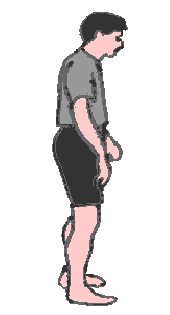 |
Can you see the "Sitting on the Toilet?"-
Imagine the swaybacked skier (diagram 1) lowering his body.
He would sit or indeed "throw himself" backward "onto the toilet"
(or other western style seat). In contrast, imagine the corrected skier
(diagram 2) lowering his body. He would be going into the full "latrine squat",
which is depicted later in this article.
Sway back while Running and Skate Skiing:
In diagrams (1) and (3) the torso is leaning backward. The lumbar spine is curved
backward beyond its strong middle range (lumbar hyper-extension). The hip joint
is also outside of its strong middle range (hip joint hyper-extension).
When Joints are worked outside of their "Strong Middle Range", they sustain Damage!
The sway back style of running/skiing is unstable, and does not make the most
efficient use of propulsive power. But worse than that, when you ski with your joints (and their
surrounding muscles and ligaments) outside of their "strong
middle range", you are sustaining damage. Pure swayback leaves you vulnerable to
back pain, Iliopsoas bursitis, and Hamstring strain(3). If in addition to sway back
your pelvis is not looking directly forward, and/or your thigh bones are rotating
inward or outward, you've opened a Pandora's box of painful hip and leg conditions!
I've been there. It's not pleasant. Chiropractors and physiotherapists are
struggling to help you. They are not trained in posture-movement analysis.
If you are a "fitness freak", your world is now filled with pain and despair.
What to do? - The following information will definitely help. If you don't have
a swayback and associated symptoms, you will still benefit from the discussion
and exercises.
|
(1) Swayback on Roller Skis
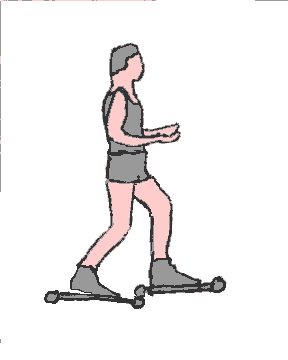
~
(2) Swayback Corrected
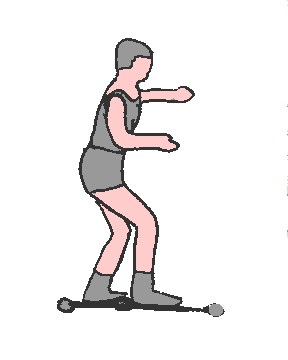
~
(3) Swayback in a Runner
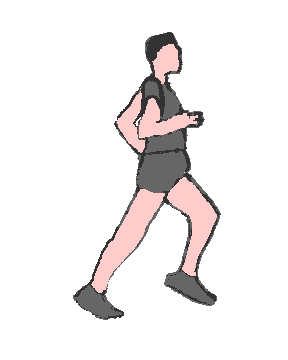
~
(4) Top Middle Distance Runner
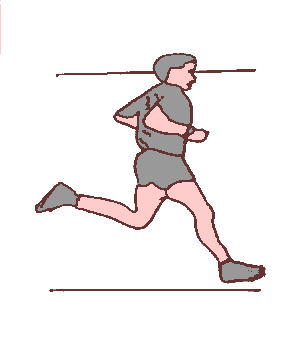
|
The Major Cause of Swayback is a Weak or Poorly Activating Gluteus maximus.
Doctors recognise a one-sided weak Gluteus maximus with the term "Gluteus maximus Limp"(9),
or "Gluteus maximus Lurch"(8). When both Gluteus maximi are activating poorly, you have
Swayback. For in depth discussion, refer to the author's article(5). Or just accept
these reasons for a weak Gluteus maximus: twisted ankle, lower back or sacral
pain, loss of "primitive" movement patterns associated with bare foot walking
and "latrine" squatting.
So how do you "fix" a Swayback?
(1) For the short term, train with a pack on your back. That'll force you to lean
forward and cause that lazy Gluteus maximus to perform its amazing stabiliser function!
That is how I managed to train for and race the 2002 Snow Rake.
(2) Look at yourself side on in the mirror. Better still get a friend to take a
photo, and label and date it for future reference. Correct your posture, and get
the feel of it. It will feel strange! Remember that strange feeling and apply
it through your day. You will initially fail most of the time because you are
fighting the postural habit of a lifetime. But do persist. I strongly recommend
a visit to an "Alexander teacher". These people are trained in posture-movement correction.
(3) Apply the following swayback posture-movement exercises and drills (note:
you must engage the Gluteus maximus for these to be fully effective):-
Sway back Posture Exercises
Note: The following exercises and movement patterns will benefit everyone,
not just those with sway back!
|
Fast barefoot walking (or jogging) on a road surface.
Pain in the feet is a powerful teacher. In this case, pain teaches your Gluteus
maximus to engage in the forward leg at the moment of foot fall, and your torso
will tend to lean forward. You cannot (assuming the road surface is painful enough)
maintain a swayback while stepping forward on bare feet! Remember the golden rule:
no matter what you are wearing on your feet, always engage the Gluteus maximus
at the moment the foot lands!
|

|
The Runner's Squat.
(The success of this as a sway back exercise depends upon engaging the gluteus maximus). This
is the single most important exercise for runners to enhance their strength and
freedom from injury. It is also important for skiers (both cross country and downhill).
|
 |
The Deep, or Latrine Squat
(The Gluteus maximus automatically engages with this movement pattern).
This sway back exercise is the perfect supplement to the runner's squat. Use this
posture as much as possible when weeding the garden!
|
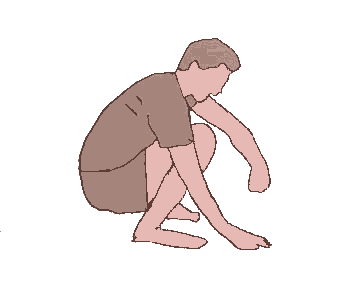 |
The "Fold" or "Monkey"
Another good sway back exercise.
Rather than "bend over" to pick up a coin, try starting the manoeuvre by
"folding" or doing the "Monkey". This motion looks trivial. It's not.
It's the lost movement pattern of civilized man. Adopt this posture when
washing dishes at a low bench. Start from this posture for all of the following
exercises/movement patterns. (Note: the success of this exercise depends upon
engaging the gluteus maximus).
|
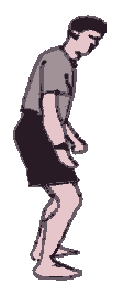 |
The Vacuum Cleaner
(The success of this exercise depends upon engaging the Gluteus maximus).
Hey Guys: offer to do the vacuuming! - This is not just a sway back exercise! This is an incredibly powerful back
repair exercise in general.
|
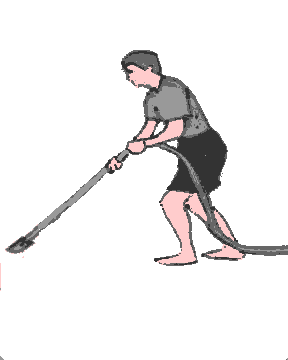 |
Correct "Sit to Stand" and "Stand to Sit" Movements.
(The success of these exercises depend upon engaging the Gluteus maximus).
Never throw yourself backward into a chair! That is the toilet sitting that the
ski instructress is telling you to avoid! Pretend that you are going into the
latrine squat, and when your bum is at seat level, perch it on the edge of the
seat, and (with the help of your hands) wiggle backward. "Stand to sit" is the
same process in reverse.
|
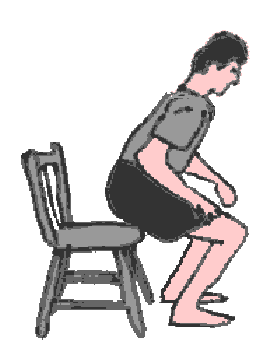 |
And finally: Correct forward stepping on skis.
The success of this movement depends upon engaging the Gluteus maximus: (1) in the rear leg, at the moment of kicking outwards and backwards, and (2) even more important, you must strongly engage Gluteus maximus in the front leg as it lands!
This is the sound foundation on which to build a powerful, co-ordinated "kick sideways and step forward"
movement. Enjoy the freedom!
|
 |
The full descriptions for these sway back posture exercise can be located at:-
Free Pilates Exercises Online Library
© Bruce Thomson, EasyVigour Project
Return to Top
Sway Back Exercise References:
- 1) Wilfred Barlow: The Alexander Principle; Arrow Books Ltd. Repr. 1987 ISBN 0/09/910160/2
- 2) B I Kodisch: Back Pain Solutions: How to help Yourself with Posture-Movement Therapy and Education
Publ. Extensional Publ.
- 3) Shirley A Sahrman: "Movement Impairment Syndromes" Publ. Mosby, 2002 ISBN 0-8016-7205-8
- 4) Owen Anderson How safe is squatting? http://www.pponline.co.uk/encyc/0827.htm
- 5) Bruce Thomson: Engage Gluteus maximus! http://www.easyvigour.net.nz/fitness/h_gluteus_maxintro.htm
- 6) Liebig EM, Kothe R*, Mannion AF, Grob D. The clinical significance of the lumbar lordosis:
relationship between lumbar spinal curvature and low back pain.
http://www.idiag.ch/deutsch/studien_e_zf5.html
- 7) William F. Robinson, Nhat M. Nguyen, Mark S. McConnell, Michael W. Whittle:
Effects of load carriage on lumbar spinal motion http://www.utc.edu/gait2002/abstracts/robinson.pdf
- 8) Wheeless' Textbook of Orthopaedics: Section on "Gait" http://www.ortho-u.net/o16/48.htm
- 9) Dave Thompson PT: "Backward Trunk Lean" http://moon.ouhsc.edu/dthompso/gait/kinetics/btl.htm
|
© Bruce Thomson, EasyVigour Project
Return to Top
|



